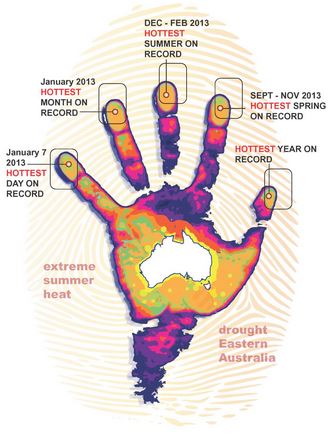Global warming hits Australia
Climate detectives reveal handprint of human-caused climate change
|
|

Australia's hottest year on record in 2013 along with the accompanying droughts, heat waves and record-breaking seasons of that year would have been virtually impossible without the influence of human-caused global warming.
Image: UNSW, P3, Helena Brusic.
Sept 29, 2014 — New research published in a special edition of the Bulletin of the American Meteorological Society (BAMS) documents the powerful influence of global warming on the Australian climate.
“Too often we talk about climate change impacts as if they are far in the future,” said ARCCSS Australian National University researcher Sophie Lewis, one of the studies’ authors. “This research shows they are here, now.”
In 2013, Australia had its hottest day on record, its hottest month on record, its hottest summer on record, its hottest spring on record and then rounded it off with the hottest year on record.
“If we were climate detectives, then Australia's hottest year on record in 2013 wasn't just a smudged fingerprint at the scene of the crime, it was a clear and unequivocal handprint showing the impact of human-caused global warming,” said Prof David Karoly, an ARCCSS researcher with the University of Melbourne.
According to the research papers in BAMS, the impact of climate change significantly increased the chances of record heat events in 2013. The researchers found global warming over Australia: doubled the chance of the most intense heat waves, tripled the likelihood of heat wave events, made extreme summer temperatures across Australia five time more likely, increased the chance of hot, dry, drought-like conditions seven times and made hot spring temperatures across Australia 30 times more likely.
But perhaps most importantly, it showed the record hot year of 2013 across Australia was virtually impossible without the influence of human-caused global warming. At its most conservative, the science showed the heat of 2013 was made 2000 times more likely by global warming.
“When it comes to what helped cause our hottest year on record, human-caused climate change is no longer a prime suspect, it is the guilty party,” said the Australian National University’s Sophie Lewis.
The extreme year of 2013 is just the latest peak in a trend over the observational record that has seen increasing bushfire days, the record-breaking warming of oceans around Australia, the movement of tropical species into temperate zones and the shifting of rain bearing storm tracks further south and away from some of our most important agricultural zones.
“If we continue to put carbon into our atmosphere at the currently accelerating rate,” said Sarah Perkins, an ARCCSS researcher with the University of New South Wales, “years like 2013 will quickly be considered normal and the impacts of future extremes will be well beyond anything modern society has experienced.”
Based on materials obtained from the AAAS. Access original article >>